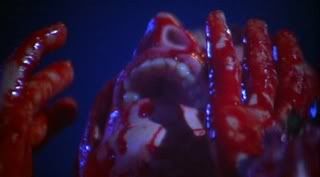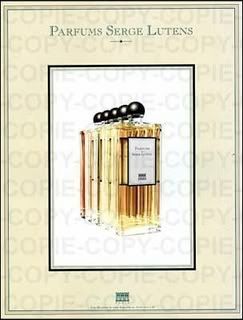
“The topaz of Ethiopia shall not equal it, neither shall it be valued with pure gold.” ~Job 28:19
The golden glory of sunrise over the beige stones of the Merenid tombs overlooking Fez has nothing on
El Attarine by Serge Lutens, nor do the riches of Arabia as it encompasses them all in its majestic stride.
"Today, I offer you gold, sun-drenched topaz, everlasting flowers and saps", Lutens and Sheldrake, his magician in the wings, had promised us and this solar fragrance has been most successfully achieved in
El Attarine.
"In Arab countries, “attarin” means sweet-smelling, and refers to everything within the realm of the
atar: fragrance, heart, flavour and essence". Attars recall the mysteries of the east,
its people and
the rituals in which they engage. The mingling of smell and taste is not unheard of in the Lutens/Sheldrake cosmos, as both
Douce Amère and
Mandarine Mandarin are impressions of gustatory speciments (
absinthe and mandarin respectively) that reveal side panels of aromas like in a Byzantine triptych ~"Attarine is not a closed door. You cannot make a perfume with only your nose".

El Attarine is also the name of a regal, elite Koranic school in Fez dating from the 14th century:
Medersa or Medressa El Attarine, (Medersa means religious school) thus the fragrance is another homage to the Arabic culture that has been providing Lutens with inspiration for the last 2 decades at least. Created in 1325 by Sultan Ya’qub Abu Said Uthman II who also had a hand in several other buildings around the city of Fez, El Attarine is situated at the edge of the spice and perfume market; the unison of carnal to spiritual is only a stone's throw away.
El Attarine, the fragrance by Lutens, bursts like the solar corona of an eclipse that is infused in the honeyed tones of the nectar of orange blossoms. This honey note, probably attributed to phenylacetic acid, which makes a much more pronounced appearence in the
derisive Miel de Bois, is here giving an intense sweetness of drops dribbling from a bronze spoon on dried fruits; fruits that lay on a basket at the market under clear blue skies, alongside little squares of heaped spices in all the colours of the rainbow: there is a little cumin, very delicately interwoven, and stamens of red saffron, the very delicate peppery bite of poppy seeds. The milky, sweet tenderness of those nuances vaguely recalls the more intense and sweaty
Arabie, with its souk ambience on a hot day. The garlands of jasmine fanned out on woody notes are discreet, as if a glimpse behind a closing shutter leaving us wondering on the surreptitious inhabitants.
And then, after about half an hour, there rises the olfactory focus of immortelle/
helychrisum, more commonly known as everlasting flower, aimed at offering a new interpretation that will set a new frontier in fragrance exploration. Both facets of the material, essence and absolute seem to have been utilized: With a complex odour profile, immortelle is a fascinating note with a herbaceous, honey-like aroma in the essential oil whereas it recalls the unique odour of spicy fenugreek (Trigonella Foenum Graecum) in the absolute, imparting amazing lasting power and evoking maple syrup for many. In
El Attarine the immortelle note is less maple-like, less sticky than Annick Goutal's archetype in
Sables and with less of a curry, salty-pungent note than
Eau Noire by Dior. Rather it has the slightly bitter, pleasurable edge also present in
L de Lolita Lempicka minus the cinnamon lappings; it offsets alongside a smidge of what smells like medicinal "oud" (a pathogenic secretion of some trees in the Far East) the initial intense sweetness into a progression than holds your attention span for the twists through the alleyways of Fez.
Like the Gettys lying on a starlit terrace in Marrakesh, beautiful and damned and a whole generation assembled as if for eternity where the curtain of the past seemed to lift before an extraordinary future, before the disillusionment and the tragic end set in,
El Attarine is a re-affirmation of a passionate relationship with both the past and the future.
El Attarine possesses that most elusive of qualities: luminous translucence which can make a fragrance appear like a faceted gem mounted in 22 carat gold: it catches every ray of the sun as it hits it from different angles into a magnificent study of light. In contrast to the byzantine candelabras of
Serge Noire, casting shadows amidst the light,
El Attarine is melting under the intense sun of a terrible dawn.

In a Parthian Shot, Serge left us with this cryptogram: "It is an accord born out of a disagreement in the first person. From my attarinian solitude, the fruits of my imagination were abundant".
It is up to you to participate into its solution by trying out
El Attarine.
The fragrance is quite lasting but with a rather discreet sillage that shouldn't pose any problems to those who are in your vicinity.
El Attarine belongs to the line of Exclusives sold only in the Salons du Palais Royal in Paris, encased in beautiful bell jars of 75ml.
Pic of Talitha and Paul Getty at The Pleasure Palace in Marrakech, shot by P.Lichfield in 1969 ~reproduced via Telegraph.co.uk. Pic of Limited Edition bottle courtesy of
El Attarine via
Ambre Gris. Pic of sunrise sent to me by mail unacredited.

.jpg)







.jpg)













